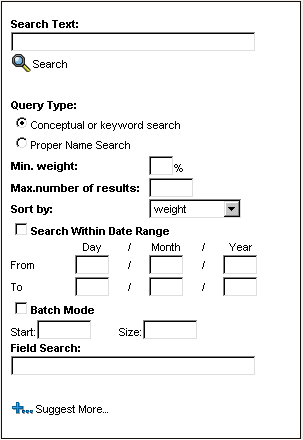
Content Management Guide
CHAPTER 18
This chapter describes how to use the Autonomy search engine to search content in the CMS Administration Console. It has these sections:
The search facility of the CMS Administration Console uses the Autonomy search engine (Dynamic Reasoning Engine, or DRE). The Autonomy DRE uses conceptual pattern matching, which is a more sophisticated form of searching than keyword-based full-text searching.
Before you can use the search facility in the CMS Administration Console, you must:
Configure the Autonomy DRE to interface properly with your server.
 For instructions on configuring Autonomy for use with your server and the CM subsystem, see the section on configuring your environment in the Content Search Guide.
For instructions on configuring Autonomy for use with your server and the CM subsystem, see the section on configuring your environment in the Content Search Guide.
Configure the CM subsystem to link to the Search service for your exteNd Director EAR project.
You can make search configuration settings when you create your project. After you have created a project, you can change search configuration settings for the CM subsystem in the exteNd Director EAR configuration tool.
NOTE: For changes in content to be immediately available to the CMS Administration Console's search facility, you must set Synchronization Mode to immediate and select which document operations you want to trigger immediate synchronization (for example, checkin and publish). In batch mode, changes are propagated to the DRE by the synch task.
If you have made configuration changes in an existing project, redeploy your project.
After you have configured you environment for the Autonomy DRE and configured the search options for your project, you can use the search facility in the CMS Administration Console.
 To perform a search in the CMS Administration Console:
To perform a search in the CMS Administration Console:
Enter content mode by clicking the Content button in the toolbar.
Enter the word or phrase you want to search for in the Search Text box.
(Optional) Set any other search options you want to use to refine your search. See Search options.
The search view In the search view:
Documents found by the search are listed in the content list. If you click a document to select it from the list, the Content Property Inspector appears, as shown in Step 2 above.
In the content list, there is a Weight column between the Name and Description columns. The numbers in the Weight column indicate the relevance of each found document to the search criteria, expressed as a percentage:
If you are not getting the results you expect If the search facility is not finding documents you expect it to find:
Make sure you have created or imported content into your repository.
Review the synchronization settings for your project. You can do this in the exteNd Director EAR Configuration tool.
If you are using immediate synchronization, make sure you have made your documents available to the search engine by performing one or more of the operations you chose when you configured immediate synchronization on each of the documents.
In the Search Pane you can set a number of options to refine your search:

The following table explains how to use the search options:
|
Option |
How to use the option |
|---|---|
|
Search Text |
Enter the word or phrase you want to search for. |
|
Query Type |
Select the type of search you want to perform:
|
|
Min. weight |
Enter the minimum weight for a document to be displayed in the content list. The weight of a found document is a measure of its relevance to the search text. The search engine assigns a percentage value to each document, with 100% representing the greatest possible relevance. |
|
Max. number of results |
Enter a number that specifies the greatest number of documents you want to be displayed in the content list. |
|
Sort by |
Select a sort order from the dropdown list. The available choices are: |
|
Search Within Date Range |
Select this check box if you want to restrict the search to documents created within a specified time period. For both the From and To dates, enter the day, month, and year in the corresponding text boxes. |
|
Batch Mode |
Check this check box if you want a subset of the found documents to appear in the content list. When using batch mode, it is helpful to think of the full set of found documents as an array, ordered according to the sort order you indicate in the Sort by box. The documents that are displayed are selected from the full set of found documents, based on the numeric values you enter in the Start and Size boxes:
Example Say you perform a search without using batch mode that returns six documents. Then you repeat the search in batch mode, indicating a Start value of 1 and a Size value of 3. The search now returns the second, third, and fourth documents from the original set of found documents, based on the order in which they initially appeared in the content list. |
|
Field Search |
Enter a field search expression. The syntax of a field search expression is: fieldname1=value1 operator fieldname2=value2 ...
where:
Example If you want to limit your search to all HTML documents written by user admin, the field search expression you would use is: author=admin AND mime-type=text/html |
|
Suggest More |
If you want to find documents related to a document that was found by previous search, select that document in the content list and click the Suggest More button. The list of documents found by the previous search is replaced by a list consisting of the selected document and any related documents. |
Copyright © 2003 Novell, Inc. All rights reserved. Copyright © 1997, 1998, 1999, 2000, 2001, 2002, 2003 SilverStream Software, LLC. All rights reserved. more ...